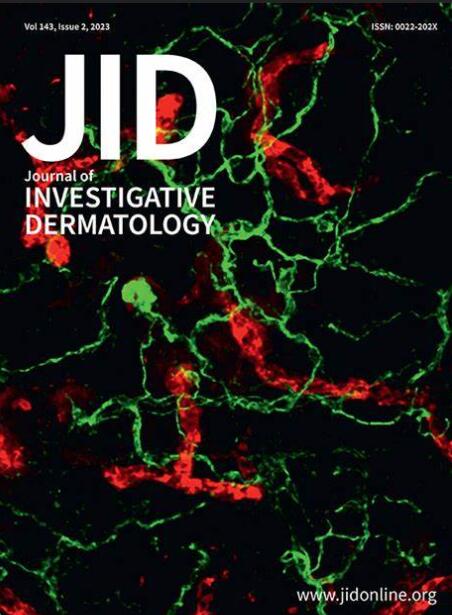乳腺癌相关淋巴水肿会导致表皮分化受损和紧密连接功能障碍。
IF 5.7
2区 医学
Q1 DERMATOLOGY
引用次数: 0
摘要
乳腺癌相关淋巴水肿(BCRL)的特点是皮肤变化、肿胀、纤维化和反复皮肤感染。临床研究表明,淋巴水肿是皮肤屏障缺陷的结果;然而,其潜在的细胞机制和细菌污染对皮肤屏障功能的影响仍然未知。在单侧BCRL患者的匹配活组织切片中,我们观察到受中度淋巴水肿或亚临床淋巴水肿影响的皮肤中,丝胶蛋白和紧密连接蛋白透明带-1(ZO-1)的表达相对于对照组(无淋巴回流且来自未受影响手臂的区域)有所下降。用淋巴水肿手术患者的淋巴液体外刺激角质形成细胞,也会导致同样的变化,并增加角蛋白 14(一种未成熟角质形成细胞的标记)的表达。最后,我们利用小鼠淋巴水肿模型表明,与临床情况一样,皮肤屏障蛋白的表达相对于正常皮肤有所下降,表皮葡萄球菌的定植会放大这种效应,并加重淋巴水肿的严重程度。综上所述,我们的研究结果表明,淋巴液淤积是导致淋巴水肿皮肤屏障功能障碍的原因之一。本文章由计算机程序翻译,如有差异,请以英文原文为准。
Breast Cancer–Related Lymphedema Results in Impaired Epidermal Differentiation and Tight Junction Dysfunction
Breast cancer–related lymphedema (BCRL) is characterized by skin changes, swelling, fibrosis, and recurrent skin infections. Clinical studies have suggested that lymphedema results in skin barrier defects; however, the underlying cellular mechanisms and the effects of bacterial contamination on skin barrier function remain unknown. In matched biopsies from patients with unilateral BCRL, we observed decreased expression of FLG and the tight junction protein ZO-1 in skin affected by moderate lymphedema or by subclinical lymphedema in which dermal backflow of lymph was identified by indocyanine green lymphography, relative to those in the controls (areas without backflow and from the unaffected arm). In vitro stimulation of keratinocytes with lymph fluid obtained from patients undergoing lymphedema surgery led to the same changes as well as increased expression of keratin 14, a marker of immature keratinocytes. Finally, using mouse models of lymphedema, we showed that similar to the clinical scenario, the expression of skin barrier proteins was decreased relative to that in normal skin and that colonization with Staphylococcus epidermidis bacteria amplified this effect as well as lymphedema severity. Taken together, our findings suggest that lymphatic fluid stasis contributes to skin barrier dysfunction in lymphedema.
求助全文
通过发布文献求助,成功后即可免费获取论文全文。
去求助
来源期刊
CiteScore
8.70
自引率
4.60%
发文量
1610
审稿时长
2 months
期刊介绍:
Journal of Investigative Dermatology (JID) publishes reports describing original research on all aspects of cutaneous biology and skin disease. Topics include biochemistry, biophysics, carcinogenesis, cell regulation, clinical research, development, embryology, epidemiology and other population-based research, extracellular matrix, genetics, immunology, melanocyte biology, microbiology, molecular and cell biology, pathology, percutaneous absorption, pharmacology, photobiology, physiology, skin structure, and wound healing

 求助内容:
求助内容: 应助结果提醒方式:
应助结果提醒方式:


